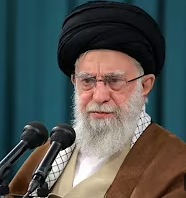The United States just pulled off the most significant military strike against Iran’s nuclear infrastructure in decades. But now, a larger question looms: What comes next? On June 21, President Trump authorized coordinated airstrikes on Iran’s nuclear sites in Fordow, Natanz, and Isfahan. The mission involved over 125 aircraft, including seven B-2 stealth bombers, guided missile submarines, fifth-generation fighters, surveillance drones, and tanker support. The Pentagon confirmed the use of decoys and strategic deception to bypass Iran’s air defenses, catching the regime completely off-guard. Satellite images and classified assessments reportedly confirm “monumental” damage to the regime’s nuclear capabilities. According to the White House, all U.S. aircraft returned safely.
Iran’s Regime Is on the Run—But Not Backing Down
Despite the precision and scope of the strike, Iran’s leadership remains defiant. Supreme Leader Ayatollah Khamenei issued a statement blaming the “Zionist-American axis” and vowed retaliation through its regional proxies. Yet military analysts suggest Iran no longer has the capability to mount a direct response. Its command-and-control infrastructure has been significantly disrupted, and its air defense grid is fractured. Iran’s Revolutionary Guard Corps (IRGC) has largely gone silent in the days since the strike, with key figures either in hiding or scrambling to regroup. Nonetheless, Iran continues to project strength for internal consumption, a tactic the regime has used in past moments of weakness.
Trump Hints at Regime Change—but Is It the Goal?
Following the strike, President Trump posted on Truth Social:
“It’s not politically correct to use the term ‘Regime Change,’ but if the current Iranian Regime is unable to MAKE IRAN GREAT AGAIN, why wouldn’t there be a Regime change??? MIGA!!!”
While the post sparked immediate debate, Trump’s administration has since clarified that regime change is not the official policy. Vice President J.D. Vance and Secretary of State Marco Rubio emphasized that the mission was narrowly focused on ending Iran’s nuclear ambitions—not toppling its government. Still, the question has been planted: What happens if the Iranian people decide the time has come?
The Internal Pressure Cooker May Be Nearing Its Boiling Point
Years of economic sanctions, internal repression, and now military humiliation have put extraordinary strain on the Iranian population. Youth unemployment is soaring. Inflation is rampant. Protests have become more frequent, especially among women and younger Iranians who have nothing but hardship under the regime. Trump’s strike may not have been designed to force regime collapse—but it might serve as a catalyst for internal revolution. Many foreign policy experts believe that only the Iranian people can truly reform their country. Any U.S.-led regime change would risk repeating the mistakes of Iraq and Afghanistan.
There’s a Reason We Haven’t Gone All In—Yet
Even among Republican leadership, the message is clear: the mission is to change Iran’s behavior, not forcefully remove its leadership. Representative Darrell Issa emphasized that Trump’s objective mirrors Reagan’s in the 1980s—military pressure to shift behavior without triggering regime collapse. But even Issa acknowledged the moral question haunting this debate: If the Iranian people rise up again, will we stand with them? “Have they risen up by the hundreds of thousands and millions, time and time again, only to find themselves being killed in the streets and the West not coming to their side?” he asked. “The hope is that yes, they may rise up and may be successful.” Lawmakers also raised real concerns about what might come after the regime. Could the IRGC consolidate power? Could terrorism surge like it did after the fall of Saddam Hussein? These are not abstract questions—they are rooted in history.
The Strategic Debate: Push Harder or Let Iran Crumble?
Some within the conservative movement argue the U.S. should finish the job and openly back regime change. Others believe Iran is already imploding from within and that too much American involvement could actually prolong the regime’s survival by giving it a new external enemy to rally against. What’s clear is this: the rules of engagement in the Middle East have changed. Trump’s strike was not just a military operation—it was a geopolitical earthquake.
What Comes Next Could Define a Generation
Whether Trump pursues further action or lets the pressure mount internally, one thing is certain: Iran’s regime has never looked weaker. Its military has been humiliated, its nuclear ambitions delayed, and its credibility shattered. For now, America holds the upper hand. But the next move won’t be made in Washington—it will likely be made in Tehran’s streets, in whispers, protests, and perhaps a final push from the very people the regime has oppressed for decades.
What do you think comes next for Iran?
Should the U.S. push for regime change, or let the Iranian people decide their own fate now that the regime is on its knees? Head to the comments and let us know—because this moment could define the next chapter in Middle East history.
Jimmy
h/t: Steadfast and Loyal

